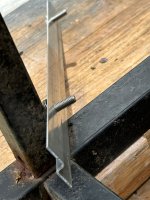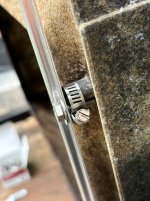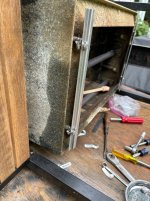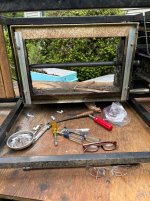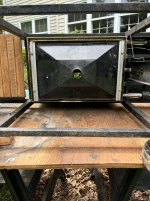Ken W - Gourmand
New member
A week ago I removed the storage cover from my Weber Genesis 1000 LX to prepare for summering grilling only to discover that the Bottom Tray was sitting at the bottom of the cart. I quickly discovered that one of the rails on the bottom of the Burner Box had partially disintegrated and no longer held the Bottom Tray to the bottom of the Burner Box. I called Weber and, bless their heart, they offered to send me replacement rails and screw at no charge! True to their word, the parts arrived a few days later. Now my trouble began. I carefully laid the Genesis on its back and saw the the original four screw were covered with corrosion. I assume it isn't rust, but I can't be sure because one of the original rails is partially missing. I think the new rails, and hence the original ones, are aluminum. The slotted hex-head screws, I just don't know. They are colored gray, but I can't determine their composition.
Obviously, the simple repair is to remove the two screws for each of the rails and just screw on the two new rails. I throughly soaked the screws with Liquid Wrench and tried to unscrew just one of the screws. I quickly discovered it would budge. Next, I attempted to use a hex-socket screwdriver and, instead of turning, the screw head started to deform. As a last effort, I tried a pair of Vise-Grips. No dice! Once again I called Weber for help. The support person placed me on hold and consulted with other members of the team. The only other suggestion they could offer was to use an Ez-Out tool. I started searching online to buy one and found a common complaint with virtually any brand was that when a great deal of force was applied the Ez-Out would snap, leaving part of the extractor embedded in the screw. This made the problem far, far worse.
So, can anyone suggest a means of my removing the old four screws so that I may replace the rails? Unless I can hold the Bottom Tray in place the Genesis cannot be used. If I could post attachment, evidently am not allowed to do so, I could show the Forum members the condition of the original screw and original rail. One original screw is still intact but the head is rounded. The remaining screws are intact and won't budge either.
Any and all suggestions would be greatly appreciated! For the want of removing the four old screws my Genesis 1000 LX is headed to the trash!
Obviously, the simple repair is to remove the two screws for each of the rails and just screw on the two new rails. I throughly soaked the screws with Liquid Wrench and tried to unscrew just one of the screws. I quickly discovered it would budge. Next, I attempted to use a hex-socket screwdriver and, instead of turning, the screw head started to deform. As a last effort, I tried a pair of Vise-Grips. No dice! Once again I called Weber for help. The support person placed me on hold and consulted with other members of the team. The only other suggestion they could offer was to use an Ez-Out tool. I started searching online to buy one and found a common complaint with virtually any brand was that when a great deal of force was applied the Ez-Out would snap, leaving part of the extractor embedded in the screw. This made the problem far, far worse.
So, can anyone suggest a means of my removing the old four screws so that I may replace the rails? Unless I can hold the Bottom Tray in place the Genesis cannot be used. If I could post attachment, evidently am not allowed to do so, I could show the Forum members the condition of the original screw and original rail. One original screw is still intact but the head is rounded. The remaining screws are intact and won't budge either.
Any and all suggestions would be greatly appreciated! For the want of removing the four old screws my Genesis 1000 LX is headed to the trash!
Last edited by a moderator:


